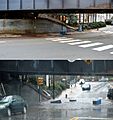Flash flood facts for kids
A flash flood is a very fast flood that happens suddenly, often without much warning. It's usually caused by a lot of rain falling quickly. It can also happen from water released by melting ice or snow. Sometimes, flash floods occur if a dam breaks.
Contents
What Causes Flash Floods?
Flash floods happen when water collects very quickly. This usually means a huge amount of rain falls in a short time. Imagine a bucket filling up too fast!
Heavy Rainfall
The most common cause is heavy rainfall. This is when a lot of rain pours down in just a few hours. This can happen during strong thunderstorms. The ground cannot soak up all the water fast enough.
Melting Ice and Snow
Sometimes, flash floods happen when a lot of ice or snow melts very quickly. This can happen if temperatures suddenly rise. The melting water rushes down hills and into valleys.
Dam Breaks
A dam is a big wall built across a river. It holds back a lot of water. If a dam breaks, all that water can rush out at once. This creates a very dangerous flash flood downstream.
Where Do Flash Floods Happen?
Flash floods can happen almost anywhere. But some places are more likely to get them.
Dry Areas
Oddly, dry areas like deserts can have flash floods. The ground there is often hard and rocky. It doesn't soak up water well. So, even a short, heavy rain can cause a flood. The Gobi Desert in Mongolia has seen flash floods after thunderstorms.
Urban Areas
Cities and towns are also at risk. They have lots of concrete and buildings. These surfaces don't absorb water. Rainwater rushes into streets and drains. If the drains can't handle it, streets quickly flood. Underpasses, like those in Charlottesville, Virginia, can fill up fast.
Mountainous Regions
Steep mountainsides can make floods worse. Water flows downhill very fast. It can pick up rocks and mud. This creates dangerous mudslides along with the flood.
Dangers of Flash Floods
Flash floods are very dangerous. They can cause a lot of damage and even loss of life.
Fast-Moving Water
The water in a flash flood moves incredibly fast. Even just six inches of moving water can knock an adult down. Two feet of water can carry away most cars. It's very hard to escape once you are caught in it.
Hidden Dangers
Floodwaters can hide many dangers. You might not see potholes, broken roads, or sharp objects. The water can also carry chemicals or sewage. This makes it unsafe to touch.
Damage to Property
Flash floods can destroy homes, businesses, and roads. They can wash away bridges and power lines. This leaves many people without power or a safe place to live. Farms can also be badly affected, like barns being flooded in Canandaigua.
Staying Safe During a Flash Flood
Knowing what to do can keep you safe.
Heed Warnings
Always listen to weather alerts. If there is a flash flood warning, take it seriously. Move to higher ground right away.
Avoid Floodwaters
Never try to drive or walk through floodwaters. "Turn around, don't drown" is a good rule to remember. The water might be deeper or faster than it looks.
Have a Plan
Talk with your family about what to do. Know where to go if your home floods. Have an emergency kit ready with food, water, and a first-aid kit.
Images for kids
-
A flash flood after a thunderstorm in the Gobi Desert, Mongolia
See also
 In Spanish: Inundación relámpago para niños
In Spanish: Inundación relámpago para niños






